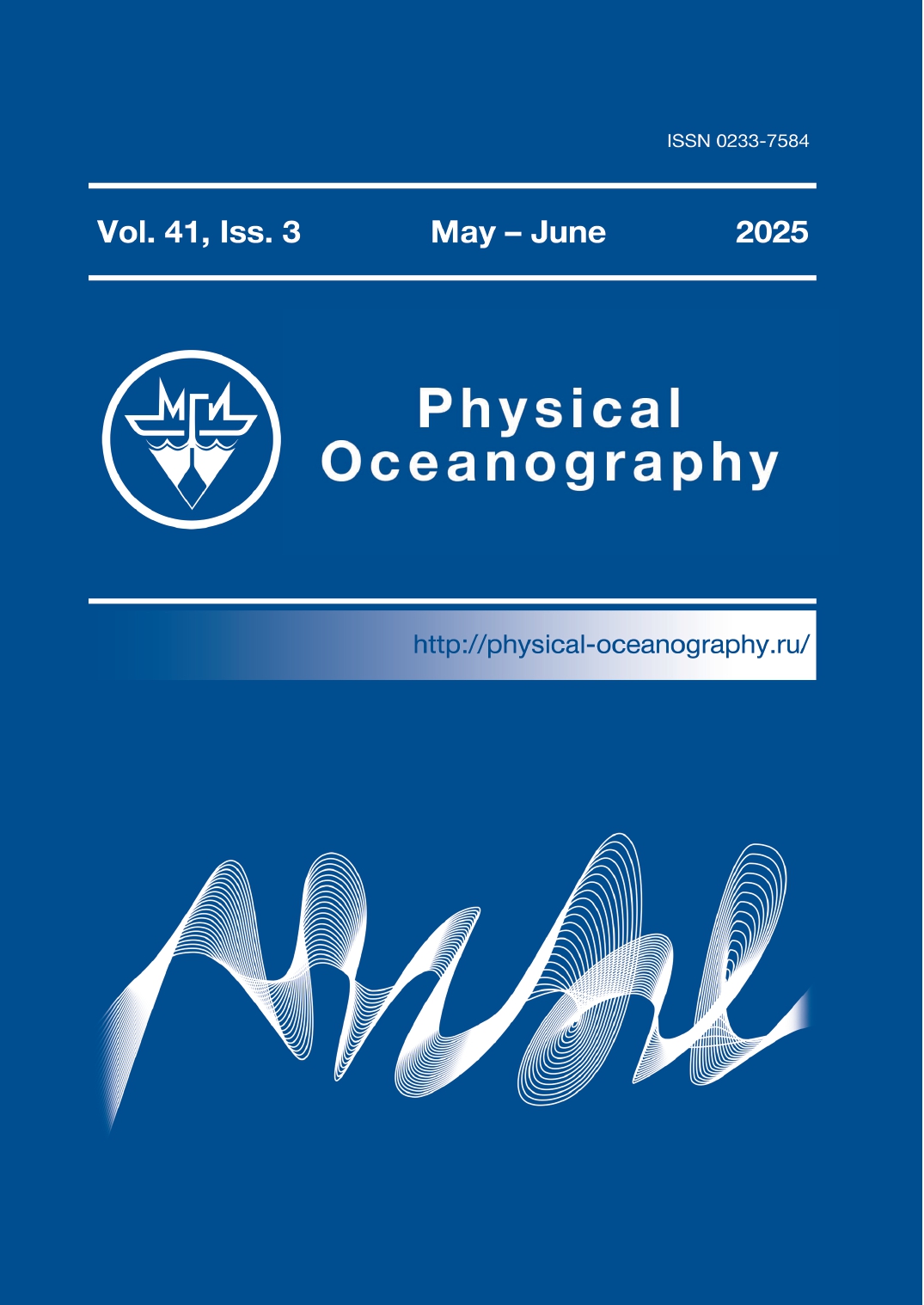Россия
Россия
Россия
Purpose. The purpose of the study is to define the spatial distribution of heavy metal concentrations in bottom sediments and identify areas of technogenic load in Balaklava Bay in 2005–2019, using different geochemical coefficients and indices. Methods and Results. The samples of the surface layer of bottom sediments (0–5 cm) were collected using a Peterson bottom grab in 2005, 2015, 2018 and 2019 and analyzed. The bulk content of elements was determined by the method of X-ray fluorescence analysis using a Spectroscan MAKS-G spectrometer. In order to assess the contribution of anthropogenic sources to bottom sediment pollution relative to the background content of metals in the coastal zone of the Crimean Peninsula shelf, the following indicators were applied: element concentration levels in sediments, total pollution indices, enrichment factors and geoaccumulation index. According to estimates of the degree of bottom sediments pollution in Balaklava Bay obtained from 2005 to 2019, the pollution level varied from low for elements such as V, Cr and Ni, to high for Cu, Zn and Pb. The most polluted areas were noted in the northern part of the basin, specifically in its central and apex parts. Bottom sediments in the Balaklava Bay basin southern part remained unpolluted throughout the period under study. Conclusions. It has been shown that the elevated level of pollution in the bottom sediments of the northern part of the bay is the result of a complex impact of natural and anthropogenic factors. However, the proximity of the polluted areas to municipal and storm water runoffs and yacht marinas suggests that the anthropogenic contribution exceeds the natural one. Furthermore, the increase in the values of the studied indices and parameters indicates that this contribution is growing over time.
Balaklava Bay, bottom sediments, heavy metals, contamination factors, enrichment factor, geoaccumulation index
1. Duan, L., Song, J., Liang, X., Yin, M., Yuan, H., Li, X., Ren, C., Zhou, B., Kang, X. [et al.], 2019.Dynamics and Diagenesis of Trace Metals in Sediments of the Changjiang Estuary. Science ofthe Total Environment, 675, pp. 247-259. https://doi.org/10.1016/j.scitotenv.2019.04.190
2. Cukrov, N., Cindrić, A.-M., Omanović, D. and Cukrov, N., 2024. Spatial Distribution, Ecological Risk Assessment, and Source Identification of Metals in Sediments of the Krka River Estuary(Croatia). Sustainability, 16(5), 1800. https://doi.org/10.3390/su16051800
3. Matishov, G.G., Bufetova, M.V. and Egorov, V.N., 2017. The Regulation of Flows of HeavyMetals into the Sea of Azov According to the Intensity of Sedimentation of Water Self-Purification. Science in the South of Russia, 13(1), pp. 44-58 (in Russian).
4. Ledin, M., 2000. Accumulation of Metals by Microorganisms – Processes and Importance forSoil Systems. Earth-Science Reviews, 51(1-4), pp. 1-31. https://doi.org/10.1016/S0012-8252(00)00008-8
5. Gnanasekaran, S. and Amal Raj, S., 2023. Heavy Metal Bioaccumulation in Sediment and Benthic Biota. In: B. A. Almayyahi, ed., 2023. Heavy Metals – Recent Advances. London: IntechOpen,pp. 1-15. https://doi.org/10.5772/intechopen.110015
6. Kovrigina, N.P., Popov, M.A., Lisitskaya, E.V., Kuftarkova, E.A. and Gubanov, V.I., 2010.Complex Monitoring of Balaklava Bay (Black Sea) in 2000-2007. Marine Ecological Journal,9(4), pp. 62-75 (in Russian).
7. Lomakin, P.D. and Popov, M.A., 2011. Oceanological Characteristic and Estimation ofthe Water Pollution in the Balaklava Bay. Sevastopol: ECOSI-Gidrofizika, 184 p. (in Russian).
8. Mukhametov, S.S. and Kondratev, S.I., 2018. Extreme Values of Hydrochemical Parameters inthe Balaklava Bay Water in February 2015. Vestnik Moskovskogo Universiteta. Seriya 5,Geografiya, (5), pp. 14-21 (in Russian).
9. Kubryakov, A.I. and Popov, M.A., 2005. Modeling of Circulation and Propagation ofContaminating Impurities in the Balaklava Bay. Physical Oceanography, 15(3), pp. 180-191.https://doi.org/10.1007/s11110-005-0040-3
10. Fomin, V.V. and Repetin, L.N., 2005. Numerical Simulation of Wind Currents and Propagationof Impurities in the Balaklava Bay. Physical Oceanography, 15(4), pp. 232-246.https://doi.org/10.1007/s11110-005-0045-y
11. Fomin, V.V. and Polozok, A.A., 2020. Wind Wave Regime in the Area of Balaklava Bay.Ecological Safety of Coastal and Shelf Zones of Sea, (2), pp. 53-67.https://doi.org/10.22449/2413-5577-2020-2-53-67 (in Russian).
12. Gurov, K.I., Ovsyany, E.I., Kotelyanets, E.A. and Konovalov, S.K., 2015. Factors of Formationand Features of Physical and Chemical Characteristics of the Bottom Sediments in the BalaklavaBay (the Black Sea). Physical Oceanography, (4), pp. 46-52. https://doi.org/10.22449/1573-160X-2015-4-46-52
13. Orekhova, N.A., Ovsyany, E.I., Gurov, K.I. and Popov, M.A., 2018. Organic Matter and Grain-Size Distribution of the Modern Bottom Sediments in the Balaklava Bay (the Black Sea). PhysicalOceanography, 25(6), pp. 479-488. https://doi.org/10.22449/1573-160X-2018-6-479-488
14. Kotelyanets, E.A., Gurov, K.I., Tikhonova, E.A. and Kondratev, S.I., 2019. Pollutants in BottomSediments in the Balaklava Bay (the Black Sea). Physical Oceanography, 26(5), pp. 414-424.https://doi.org/10.22449/1573-160X-2019-5-414-424
15. Tikhonova, E.A., Kotelyanets, E.A. and Gurov, K.I., 2019. Content of Organic Compounds andTrace Metals in Bottom Sediments of the Balaklava Bay (the Black Sea). Ecological Safety ofCoastal and Shelf Zones of Sea, (3), pp. 82-89. https://doi.org/10.22449/2413-5577-2019-3-82-89 (in Russian).
16. Gurov, K.I. and Fomin, V.V., 2021. Mathematical Modeling the Dynamics of the BottomSediments Granulometric Composition in the Balaklava Bay Affected by the Wind Waves.Physical Oceanography, 28(1), pp. 78-89. https://doi.org/10.22449/1573-160X-2021-1-78-89
17. Kremenchutskii, D.A. and Gurov, K.I., 2021. Distribution of 137Cs and 40K in the BottomSediments of the Balaklava Bay (the Black Sea). Physical Oceanography, 28(2), pp. 191-204.https://doi.org/10.22449/1573-160X-2021-2-191-204
18. Soloveva, O.V., Tikhonova, E.A., Gurov, K.I. and Kotelyanets, E.A., 2023. HydrocarbonsComposition of Sea Bottom Sediments (Balaklava Bay, Black Sea). International Journal ofEnvironmental Science and Technology, 20(3), pp. 2405-2416. https://doi.org/10.1007/s13762-022-04167-y
19. Burgess, R.M., Terletskaya, A.V., Milyukin, M.V., Povolotskii, M., Demchenko, V.Y.,Bogoslavskaya, T.A., Topkin, Y.V., Vorobyova, T.V., Petrov, A.N. [et al.], 2009. Concentrationand Distribution of Hydrophobic Organic Contaminants and Metals in the Estuaries of Ukraine.Marine Pollution Bulletin, 58(8), pp. 1103-1115.https://doi.org/10.1016/j.marpolbul.2009.04.013
20. Gurov, K.I., Kurinnaya, Yu.S. and Kotelyanets, E.A., 2021. Features of Accumulation and SpatialDistribution of Microelements in Bottom Sediments of the Crimea Coastal Regions. In: T.Chaplina, ed., 2021. Processes in GeoMedia – Volume III. Springer Geology Series. Cham:Springer, pp. 119-130. https://doi.org/10.1007/978-3-030-69040-3_12
21. Bat, L., Ӧzkan, E.Y. and Ӧztekin, H.C., 2015. The Contamination Status of Trace Metals in SinopCoast of the Black Sea, Turkey. Caspian Journal of Environmental Sciences, 13(1), pp. 1-10.
22. Korablina, I.V., Barabashin, T.O. and Katalevsky, N.I., 2021. Heavy Metals in the BottomSediments of the Black Sea Northwestern Shelf in Recent Years. Physical Oceanography, 28(5),pp. 549-566. https://doi.org/10.22449/1573-160X-2021-5-549-566
23. Ardila, P.A.R., Alonso, R.Á., Valsero, J.J.D., García, R.M., Cabrera, F. Á., Cosío, E.L. andLaforet, S.D., 2023. Assessment of Heavy Metal Pollution in Marine Sediments from Southwestof Mallorca Island, Spain. Environmental Science and Pollution Research, 30(7), pp. 16852-16866. https://doi.org/10.1007/s11356-022-25014-0
24. Soliman, N.F., Nasr, S.M. and Okbah, M.A., 2015. Potential Ecological Risk of Heavy Metals inSediments from the Mediterranean Coast, Egypt. Journal of Environmental Health Science andEngineering, 13(1), 70. https://doi.org/10.1186/s40201-015-0223-x
25. Chifflet, S., Tedetti, M., Zouch, H., Fourati, R., Zaghden, H., Elleuch, B., Quéméneur, M., Karray, F. and Sayadi, S., 2019. Dynamics of Trace Metals in a Shallow Coastal Ecosystem: Insights from the Gulf of Gabès (Southern Mediterranean Sea). AIMS Environmental Science, 6(4), pp. 277- 297. https://doi.org/10.3934/environsci.2019.4.277
26. Youssef, M. and El-Sorogy, A., 2016. Environmental Assessment of Heavy Metal Contaminationin Bottom Sediments of Al-Kharrar Lagoon, Rabigh, Red Sea, Saudi Arabia. Arabian Journal ofGeosciences, 9(6), 474. https://doi.org/10.1007/s12517-016-2498-3
27. Zhang, J. and Gao, X., 2015. Heavy Metals in Surface Sediments of the Intertidal Laizhou Bay,Bohai Sea, China: Distributions, Sources and Contamination Assessment. Marine PollutionBulletin, 98(1-2), pp. 320-327. https://doi.org/10.1016/j.marpolbul.2015.06.035
28. Fukushima, K., Saino, T. and Kodama, Y., 1992. Trace Metal Contamination in Tokyo Bay,Japan. Science of the Total Environment, 125, pp. 373-389. https://doi.org/10.1016/0048-9697(92)90402-E
29. Bothner, M.H., Buchholtz Ten Brink, M. and Manheim, F.T., 1998. Metal Concentrations inSurface Sediments of Boston Harbor: Changes with Time. Marine Environmental Research,45(2), pp. 127-155. https://doi.org/10.1016/S0141-1136(97)00027-5
30. Ho, K.T., Burgess, R.M., Pelletier, M.C., Serbst, J.R., Ryba, S.A., Cantwell, M.G., Kuhn, A. andRaczelowski, P., 2002. An Overview of Toxicant Identification in Sediments and DredgedMaterials. Marine Pollution Bulletin, 44(4), pp. 286-293. https://doi.org/10.1016/S0025-326X(01)00251-X
31. Charlesworth, S., Everett, M., McCarthy, R., Ordóñez, A. and De Miguel, E., 2003.A Comparative Study of Heavy Metal Concentration and Distribution in Deposited Street Dustsin a Large and a Small Urban Area: Birmingham and Coventry, West Midlands, UK. EnvironmentInternational, 29(5), pp. 563-573. https://doi.org/10.1016/S0160-4120(03)00015-1
32. Lu, X., Wang, L., Lei, K., Huang, J. and Zhai, Y., 2009. Contamination Assessment of Copper, Lead, Zinc, Manganese and Nickel in Street Dust of Baoji, NW China. Journal of Hazardous Materials, 161(2-3), pp. 1058-1062. https://doi.org/10.1016/j.jhazmat.2008.04.052
33. Chon, H.-T., Kim, K.-W. and Kim, J.-Y. Metal Contamination of Soils and Dusts in SeoulMetropolitan City, Korea. Environmental Geochemistry and Health, 17(3), pp. 139-146.https://doi.org/10.1007/BF00126082
34. Hakanson, L., 1980. An Ecological Risk Index for Aquatic Pollution Control. A SedimentologicalApproach. Water Research, 14(8), pp. 975-1001. https://doi.org/10.1016/0043-1354(80)90143-8
35. Tomlinson, D.L., Wilson, J.G., Harris, C.R. and Jeffrey, D.W., 1980. Problems in the Assessmentof Heavy-Metal Levels in Estuaries and the Formation of a Pollution Index. HelgoländerMeeresuntersuchungen, 33(1-4), pp. 566-575. http://dx.doi.org/10.1007/BF02414780
36. Muller, G., 1979. Schwermetalle in den Sedimenten des Rheins: Veranderungen seit 1971.Umschau, 79, pp. 778-783 (in German).
37. Ovsyany, E.I., Kotelyanets, E.A. and Orekhova, N.A., 2009. Arsenic and Heavy Metals inthe Bottom Sediments of the Balaklava Bay (Black Sea). Physical Oceanography, 19(4), pp. 254-266. https://doi.org/10.1007/s11110-009-9048-4
38. Bantan, R.A., Al-Dubai, T.A. and Al-Zubieri, A.G., 2020. Geo-Environmental Assessment ofHeavy Metals in the Bottom Sediments of the Southern Corniche of Jeddah, Saudi Arabia. MarinePollution Bulletin, 161, part A, 111721. https://doi.org/10.1016/j.marpolbul.2020.111721
39. Habib, S.B., Hossain, M.B., Hossain, Md.S., Jolly, Y.N. and Sarker, S., 2021. Ecological RiskEvaluation in Bottom-Surface Sediments and Sub-Surface Water in the Subtropical MeghnaEstuarine System. Heliyon, 7(11), e08324. https://doi.org/10.1016/j.heliyon.2021.e08324
40. Zoller, W.H., Gladney, E.S. and Duce, R.A., 1974. Atmospheric Concentrations and Sources ofTrace Metals at the South Pole. Science, 183(4121), pp. 198-200.https://doi.org/10.1126/science.183.4121.198
41. Liu, R., Bao, K., Yao, S., Yang, F. and Wang, X., 2018. Ecological Risk Assessment andDistribution of Potentially Harmful Trace Elements in Lake Sediments of Songnen Plain, NEChina. Ecotoxicology and Environmental Safety, 163(10), pp. 117-124.https://doi.org/10.1016/j.ecoenv.2018.07.037
42. Mehlhorn, P., Newman, B. and Haberzettl, T., 2024. Comparison of Different Normalisers forIdentifying Metal Enrichment of Sediment: A Case Study from Richards Bay Harbour, SouthAfrica. In: G.P. von Maltitz, G.F. Midgley, J. Veitch, C. Brümmer, R.P. Rötter, F.A. Veihbergand M. Veste, eds., 2024. Sustainability of Southern African Ecosystems under Global Change.Ecological Studies Series, vol. 248. Cham: Springer, pp. 787-814. https://doi.org/10.1007/978-3-031-10948-5_27
43. Jaskuła, J., Sojka, M., Fiedler, M. and Wróżyński, R., 2021. Analysis of Spatial Variability ofRiver Bottom Sediment Pollution with Heavy Metals and Assessment of Potential EcologicalHazard for the Warta River, Poland. Minerals, 11(3), 327. https://doi.org/10.3390/min11030327
44. Ontiveros-Cuadras, J.F., Ruiz-Fernández, A.C., Pérez-Bernal, L.H., Raygoza-Viera, J.R. andSanchez-Cabeza, J.-A., 2021. Historical Reconstruction of Trace Element Concentrations and Fluxes in a Tropical Coastal Lagoon (Mexican Pacific) Derived from 210Pb Radiochronology. Continental Shelf Research, 213, 104315. https://doi.org/10.1016/j.csr.2020.104315
45. Zhang, J. and Liu, C.L., 2002. Riverine Composition and Estuarine Geochemistry of ParticulateMetals in China – Weathering Features, Anthropogenic Impact and Chemical Fluxes. Estuarine, Coastal and Shelf Science, 54(6), pp. 1051-1070. https://doi.org/10.1006/ecss.2001.0879
46. Essien, J.P., Antai, S.P. and Olajire, A.A., 2009. Distribution, Seasonal Variations andEcotoxicological Significance of Heavy Metals in Sediments of Cross River Estuary Mangrove Swamp. Water, Air, and Soil Pollution, 197(1-4), pp. 91-105. https://doi.org/10.1007/s11270-008-9793-x
47. Salomons, W. and Förstner, U., 1984. Metals in the Hydrocycle. Berlin, Heidelberg: Springer-Verlag, 352 p. https://doi.org/10.1007/978-3-642-69325-0
48. Özşeker, K., Erüz, C. and Terzı̇, Y., 2022. Evaluation of Toxic Metals in Different Grain SizeFractions of Sediments of the Southeastern Black Sea. Marine Pollution Bulletin, 182, 113959. https://doi.org/10.1016/j.marpolbul.2022.113959
49. Que, W., Yi, L., Wu, Y. and Li, Q., 2024. Analysis of Heavy Metals in Sediments with DifferentParticle Sizes and Influencing Factors in a Mining Area in Hunan Province. Scientific Reports, 14(1), 20318. https://doi.org/10.1038/s41598-024-71502-3
50. Abdallah, M.A.M., 2023. Accumulation and Distribution of Heavy Metals in Surface Sedimentsfrom the Continental Shelf Adjacent to Abu Qir Bay, Egypt, as a Function of Grain Size. Geo-Marine Letters, 43(1), 2. https://doi.org/10.1007/s00367-022-00743-w














